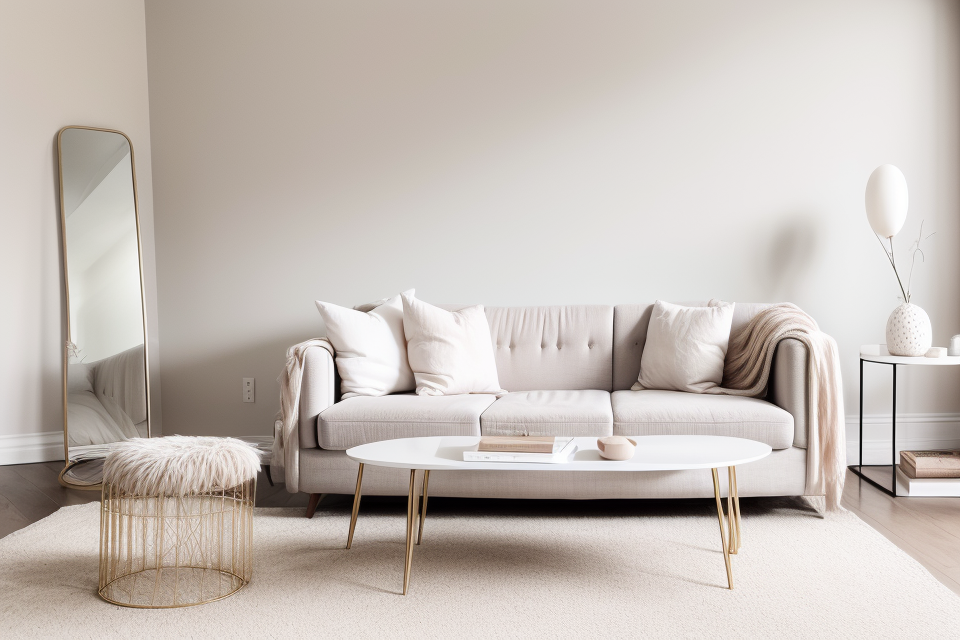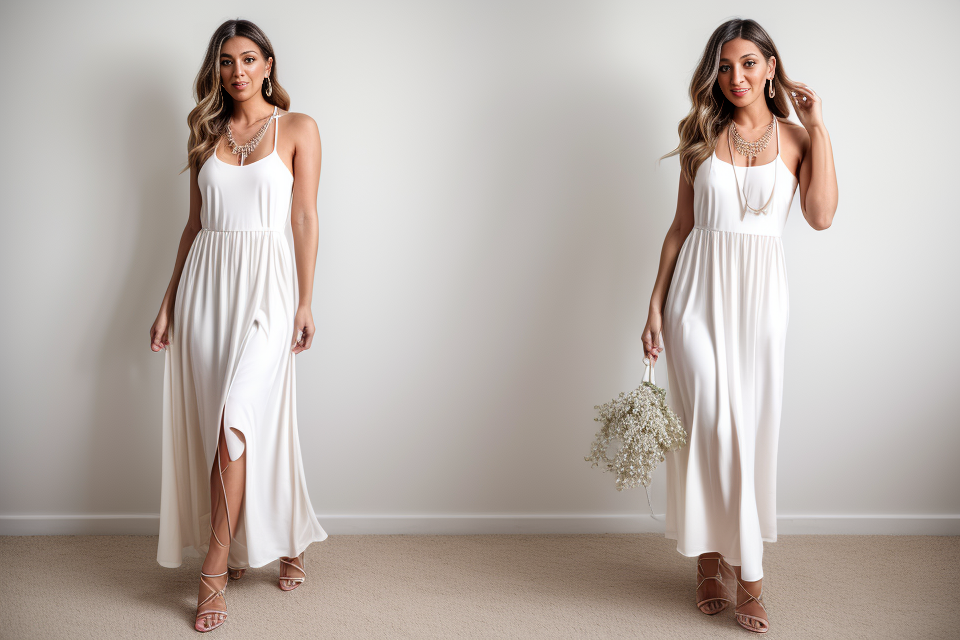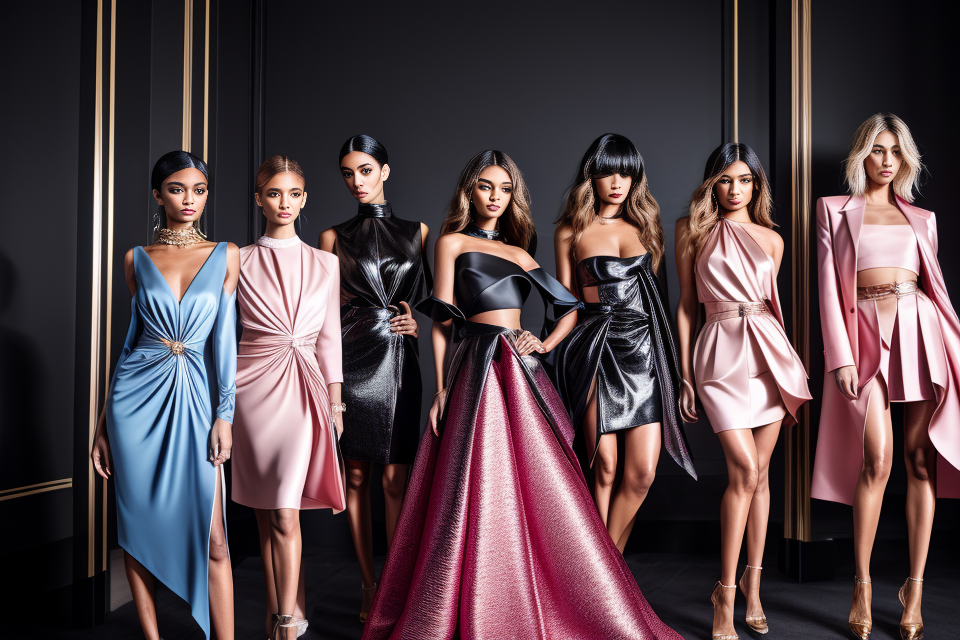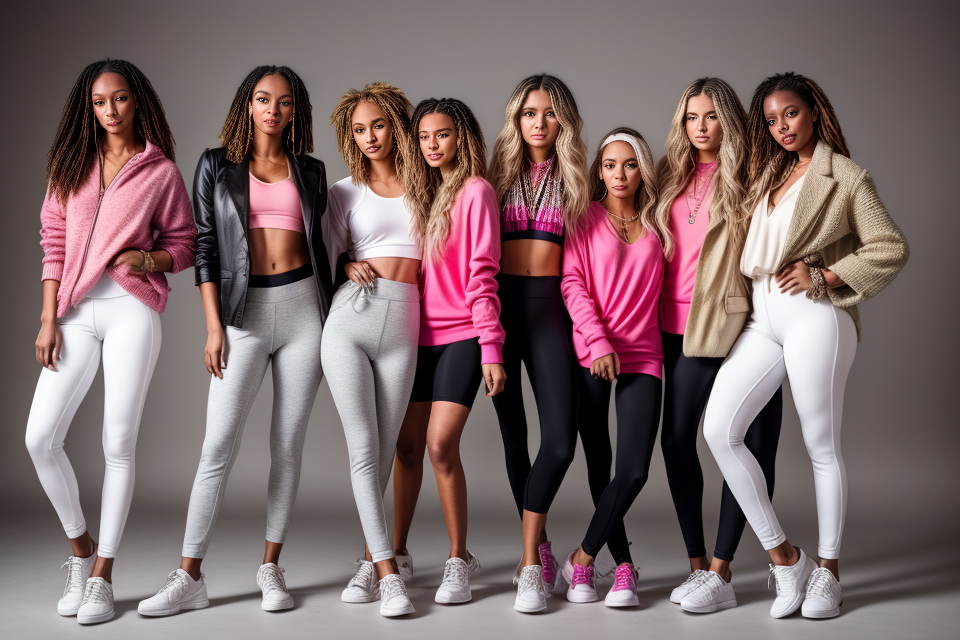
The question of what makes a good outfit is a timeless one that has puzzled fashion lovers for centuries. Is it the perfect pair of jeans? The right accessory? A stunning statement piece? The truth is, there’s no one answer to this question. However, there are certain essential elements that can help take your outfit from average to extraordinary. In this comprehensive guide, we’ll explore the key components of a perfect outfit, from timeless fashion staples to the latest trends. So, whether you’re a fashion novice or a seasoned pro, read on to discover the secrets to creating a truly unforgettable look.
Balancing Basics and Creativity
Finding the Right Proportions
One of the most crucial aspects of achieving a perfect outfit is finding the right proportions. Proportions refer to the size relationship between different elements of your outfit, such as the length of your top compared to the length of your pants or the size of your accessories in relation to your clothing.
When it comes to proportions, there are a few key things to keep in mind:
- The rule of thirds: When composing an outfit, try to balance it using the rule of thirds. This means that the focal point of your outfit should be placed at one-third of the way up or down from the top or bottom of the outfit.
- Balancing the top and bottom: Your top and bottom pieces should be proportionate to each other. For example, if you’re wearing a loose-fitting top, balance it out with a pair of fitted pants or a skirt.
- The right amount of skin: Showing too much skin can make an outfit look unbalanced, while not enough skin can make it look boring. Strike a balance by choosing clothing that shows the right amount of skin for the occasion.
- Layering: Layering can be a great way to add interest and dimension to your outfit. Try adding a light jacket or cardigan over a fitted top, or pairing a long-sleeved shirt with shorts.
By paying attention to these proportions, you can create an outfit that is both visually appealing and balanced.
Adding Personal Style
- Experimenting with Textures and Patterns
- When it comes to adding personal style to an outfit, experimenting with textures and patterns is a great place to start. This can be as simple as pairing a striped shirt with a polka dot scarf, or as bold as mixing multiple patterns in one outfit. The key is to have fun and not be afraid to try new things.
- Incorporating Unique Accessories
- Another way to add personal style to an outfit is by incorporating unique accessories. This can include things like statement jewelry, scarves, hats, belts, and more. The idea is to find accessories that complement your outfit and add a touch of your own personality to the look. For example, if you’re wearing a simple black dress, you could add a bold statement necklace to make the outfit your own.
Mastering the Art of Layering
Layering for a Polished Look
- Tips for Layering Necklaces
- Mix and match metals
- Stack delicate necklaces
- Pair statement necklaces with simpler pieces
- Mixing Bold Colors and Prints
- Experiment with contrasting patterns
- Create a cohesive look with a common color scheme
- Keep the balance with neutral colors
Layering is an essential skill to master when it comes to creating a polished and stylish outfit. By strategically layering different pieces, you can create a look that is both trendy and sophisticated. Here are some tips for layering necklaces and mixing bold colors and prints to achieve a polished look.
Tips for Layering Necklaces
Mix and match metals to create a unique and stylish look. Try pairing a gold pendant with a silver chain or a rose gold bracelet with a yellow gold necklace. This will add dimension and interest to your outfit.
Stack delicate necklaces to create a layered look. Layering thin chains or delicate pendants can add a touch of elegance to any outfit. Try layering a simple chain with a statement pendant or layering multiple delicate chains for a bohemian-inspired look.
Pair statement necklaces with simpler pieces to create a balanced look. Statement necklaces can make a bold statement, but they can also overpower an outfit. To create a balanced look, pair a statement necklace with simpler pieces like a basic t-shirt or a delicate bracelet.
Mixing Bold Colors and Prints
Experiment with contrasting patterns to create a bold and trendy look. Mixing patterns can be intimidating, but it can also create a visually stunning outfit. Try pairing a large polka dot print with a small floral print or a striped shirt with a plaid skirt.
Create a cohesive look with a common color scheme. When mixing bold colors and prints, it’s important to create a cohesive look. One way to do this is to choose a common color scheme and use it throughout your outfit. For example, if you’re wearing a blue and white striped shirt, pair it with blue jeans and white sneakers for a cohesive look.
Keep the balance with neutral colors. When mixing bold colors and prints, it’s important to balance them with neutral colors. Neutral colors like black, white, and beige can help ground the look and prevent it from being too overwhelming. Try pairing a bold printed top with black pants and white sneakers for a balanced look.
Nailing the Athleisure Trend
Mixing Activewear with Elevated Pieces
Incorporating activewear into your wardrobe has never been easier. By pairing athletic clothing with more sophisticated pieces, you can create a stylish and functional outfit that’s perfect for any occasion. For example, try pairing a sleek tracksuit with a tailored blazer and high heels for a chic and comfortable look.
Styling Sneakers with Dresses and Skirts
Sneakers have become a wardrobe staple for many fashion-conscious individuals. To create a modern and edgy outfit, try pairing sneakers with dresses and skirts. A white t-shirt dress paired with white sneakers is a classic and versatile combination that can be dressed up or down depending on the occasion. Additionally, you can add a denim jacket or a leather moto jacket to create a more rugged and fashionable look.
Creating a Capsule Wardrobe
The Power of Investment Pieces
Identifying Timeless Pieces
Investment pieces are wardrobe staples that transcend trends and can be worn for years to come. To identify timeless pieces, consider the following:
- Classic silhouettes: Look for items that fit well and flatter your body shape, such as tailored trousers, A-line dresses, and blazers.
- Neutral colors: Choose a color palette that complements your skin tone and hair color, focusing on neutral hues like black, white, navy, and beige.
- High-quality materials: Invest in fabrics that are durable, breathable, and easy to care for, such as cotton, linen, and silk.
Maximizing Versatility
Investment pieces should be versatile and adaptable to different occasions and styles. To maximize versatility, consider the following:
- Mix and match: Pair investment pieces with other items in your wardrobe to create a variety of outfits. For example, a tailored blazer can be worn with jeans, a dress, or a skirt.
- Accessorize: Add accessories such as belts, scarves, and jewelry to change the look of an investment piece. A classic coat can be transformed with a statement necklace or a colorful scarf.
- Layering: Investment pieces can be layered with other garments to create seasonal looks. A tailored vest can be worn under a coat in winter or over a shirt in spring.
By identifying timeless pieces and maximizing their versatility, you can create a capsule wardrobe that is both stylish and practical.
Embracing Minimalism
Decluttering Your Wardrobe
The first step in embracing minimalism is to declutter your wardrobe. This means getting rid of any clothes that no longer fit, are worn out, or that you simply don’t wear anymore. It’s important to be ruthless when decluttering, as the more items you have, the harder it will be to choose an outfit each morning. Consider donating items that are still in good condition to charity, or selling them online.
Styling Basics for a Polished Look
Once you’ve decluttered your wardrobe, it’s time to focus on styling basics for a polished look. This means investing in a few key pieces that can be mixed and matched to create a variety of outfits. Think classic pieces such as a tailored blazer, a pair of high-waisted trousers, and a simple tank top or t-shirt. These pieces can be dressed up or down depending on the occasion, and will form the foundation of your capsule wardrobe.
By following these steps, you’ll be well on your way to creating a perfect outfit that is both stylish and practical.
The Art of Accessorizing
The Power of Statement Accessories
- Choosing Bold Statement Pieces
When it comes to statement accessories, the key is to choose bold pieces that make a statement. Think oversized earrings, chunky necklaces, and statement bracelets. These types of accessories can instantly elevate an outfit and add a pop of personality to any look. - Mixing Metals and Colors
Another way to make a statement with accessories is by mixing metals and colors. This can add a unique and interesting element to an outfit. For example, pairing gold and silver jewelry or wearing a brightly colored scarf with a neutral outfit. This can help create a cohesive and stylish look.
Mastering the Basics
When it comes to accessorizing an outfit, there are a few key things to keep in mind. First and foremost, it’s important to understand that quality is key. Investing in a few high-quality accessories that will last a long time is much more cost-effective in the long run than constantly buying cheap, disposable pieces.
Another important aspect of mastering the basics of accessorizing is understanding that certain accessories are essential for every outfit. For example, a classic watch is a must-have for both men and women, and a good pair of sunglasses can add a touch of sophistication to any look.
It’s also important to consider the occasion and the overall aesthetic of the outfit when choosing accessories. For example, a statement necklace can add a pop of color to a neutral outfit, while delicate earrings can complement a more elaborate dress.
Lastly, it’s important to remember that less is often more when it comes to accessorizing. A cluttered outfit with too many accessories can look overwhelming and disheveled, so it’s important to choose a few key pieces that will complement the outfit and enhance the overall look.
The Psychology of Dressing for Success
The Impact of Color
When it comes to creating a perfect outfit, the color of your clothing plays a crucial role. Color can impact how others perceive you, and it can even affect your own mood and confidence level. Here are some key points to consider when choosing colors for your outfits:
- Choosing Colors for Different Occasions: Different colors are associated with different moods and occasions. For example, red is often associated with passion and energy, making it a great choice for a bold and vibrant evening gown. On the other hand, blue is often associated with calmness and tranquility, making it a great choice for a business setting.
- Understanding Color Psychology: The colors you choose can also impact how others perceive you. For example, research has shown that people perceived as more intelligent when they wear colors like blue and green. In contrast, people perceived as more creative when they wear colors like purple and orange.
- Color Combinations: The colors you choose should also complement each other. For example, pairing a warm color like red with a cool color like blue can create a visually striking combination.
- Skin Tone: It’s also important to consider your skin tone when choosing colors. If you have a cool skin tone, you may want to stick to colors like blue, green, and purple. If you have a warm skin tone, you may want to stick to colors like red, orange, and yellow.
By considering these factors, you can make informed decisions about the colors you choose for your outfits, and create a look that is both stylish and impactful.
Dressing for Confidence
Dressing for confidence plays a crucial role in how one perceives themselves and their overall self-esteem. It’s important to understand that confidence comes from within, but our external appearance can greatly influence our confidence levels. When we feel good about how we look, we tend to carry ourselves with more poise and self-assurance. Here are some key points to consider when dressing for confidence:
- The Role of Posture and Confidence in Dressing
- Our posture can greatly affect how we feel about ourselves and how others perceive us. When we stand tall and confident, it sends a message of strength and assertiveness.
- Dressing in a way that enhances our natural posture can help us feel more confident. For example, wearing well-fitted clothing that accentuates our best features can give us a boost of confidence.
- Embracing Your Unique Style
- It’s important to embrace your unique style and individuality. This means dressing in a way that reflects your personality and makes you feel comfortable and confident.
- It’s also important to remember that what looks good on one person may not necessarily look good on another. Trust your instincts and don’t be afraid to experiment with different styles until you find what works best for you.
Overall, dressing for confidence involves dressing in a way that makes you feel good about yourself and enhances your natural posture. By embracing your unique style and individuality, you can exude confidence and poise in all aspects of your life.
The Future of Fashion: Sustainability and Ethical Consumerism
Embracing Sustainable Fashion
As consumers become increasingly aware of the environmental and social impact of their purchases, sustainable fashion has emerged as a crucial aspect of ethical consumerism. The fashion industry is one of the largest polluters in the world, and fast fashion has exacerbated the problem by promoting disposable clothing and encouraging overconsumption. Therefore, embracing sustainable fashion is not only a moral imperative but also a necessary step towards a more sustainable future.
Here are some ways to embrace sustainable fashion:
- Understanding the Impact of Fast Fashion
Fast fashion is a business model that prioritizes speed and low prices over quality and sustainability. It relies on the rapid production of trendy clothing inspired by catwalk designs, which are then sold at low prices to consumers. The problem with fast fashion is that it encourages consumers to buy more clothes than they need, leading to excessive waste and pollution. Additionally, fast fashion often uses unethical labor practices and exploits workers in developing countries.
- Investing in Sustainable Brands
Sustainable fashion brands prioritize ethical and environmentally friendly practices in their production processes. They use eco-friendly materials, reduce waste, and promote fair labor practices. Some sustainable fashion brands include Everlane, Patagonia, and Eileen Fisher. Investing in these brands supports sustainable practices and sends a message to the fashion industry that consumers are interested in ethical fashion.
- Buying Second-Hand Clothes
Buying second-hand clothes is an excellent way to reduce waste and support sustainable fashion. Thrift stores, consignment shops, and online marketplaces like Poshmark and The RealReal offer a wide range of gently used clothing at affordable prices. Buying second-hand clothes not only reduces the demand for new clothing but also gives new life to old clothes, reducing waste and pollution.
- Caring for Clothes
Finally, caring for clothes is an essential aspect of sustainable fashion. Extending the life of clothes by repairing them, repurposing them, or upcycling them is a sustainable way to reduce waste and pollution. Additionally, proper care and maintenance of clothes can extend their lifespan, reducing the need for new clothing.
In conclusion, embracing sustainable fashion is crucial for a more sustainable future. By understanding the impact of fast fashion, investing in sustainable brands, buying second-hand clothes, and caring for clothes, consumers can make a difference in the fashion industry and promote ethical and environmentally friendly practices.
The Power of Ethical Consumerism
Ethical consumerism refers to the practice of making conscious choices as a consumer to support businesses that operate ethically and sustainably. This can include choosing clothing brands that prioritize fair labor practices, environmentally friendly production methods, and transparency in their supply chains. By doing so, consumers can help drive positive change in the fashion industry and contribute to a more sustainable future.
One of the key aspects of ethical consumerism in fashion is supporting fair labor practices. This means ensuring that garment workers are paid a living wage, have safe working conditions, and are treated with dignity and respect. Many fashion brands, particularly those that operate on a fast fashion model, have been criticized for exploiting workers and paying them below poverty-level wages. By choosing to support brands that prioritize fair labor practices, consumers can help improve working conditions for garment workers and promote more equitable labor standards in the industry.
Another important aspect of ethical consumerism in fashion is making conscious choices in your wardrobe. This means being mindful of the materials used to produce your clothing, as well as the environmental impact of your purchases. For example, choosing clothing made from sustainable materials like organic cotton or recycled polyester can help reduce your environmental footprint and support more sustainable production methods. Additionally, choosing to buy fewer, higher-quality items that will last longer can help reduce waste and promote a more sustainable approach to fashion.
By engaging in ethical consumerism, fashion consumers can have a powerful impact on the industry and promote more sustainable and ethical practices. By making conscious choices in their wardrobe, consumers can help drive demand for more sustainable and ethical fashion, and encourage brands to prioritize these values in their operations.
FAQs
1. What are the essential elements of a good outfit?
A good outfit consists of several essential elements that work together to create a cohesive and stylish look. The essential elements of a good outfit include a balance of colors, patterns, and textures, a flattering fit, appropriate accessories, and a statement piece or focal point.
2. How do I choose the right colors for my outfit?
Choosing the right colors for your outfit can make a big difference in how you look and feel. The key is to choose colors that flatter your skin tone and complement your hair and eye color. You can also consider the occasion and the overall mood you want to convey when choosing colors for your outfit.
3. How do I balance patterns and textures in my outfit?
Balancing patterns and textures in your outfit can be challenging, but it’s essential for creating a cohesive and stylish look. To balance patterns and textures, try pairing patterns of different scales or combining textures that contrast with each other, such as pairing a patterned top with a solid-colored skirt.
4. How do I ensure a good fit for my outfit?
A good fit is crucial for creating a flattering and stylish outfit. To ensure a good fit, start by selecting the right size and cut for your body type. Then, have your clothes altered if necessary to ensure a perfect fit. A well-fitting outfit can make a significant difference in how you look and feel.
5. How do I choose the right accessories for my outfit?
Accessories can make or break an outfit, so it’s essential to choose the right ones. When choosing accessories, consider the overall style of your outfit and the occasion. Aim to choose accessories that complement your outfit and add interest without overpowering it.
6. What is a statement piece or focal point, and how do I incorporate it into my outfit?
A statement piece or focal point is an eye-catching element that adds interest and personality to your outfit. It could be a bold necklace, a statement coat, or a pair of bright shoes. To incorporate a statement piece into your outfit, start by choosing a neutral base and then adding the statement piece to make the outfit pop.


